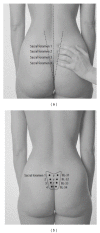Comparison of the effects of maternal supportive care and acupressure (BL32 acupoint) on pregnant women's pain intensity and delivery outcome
- PMID: 25210629
- PMCID: PMC4152932
- DOI: 10.1155/2014/129208
Comparison of the effects of maternal supportive care and acupressure (BL32 acupoint) on pregnant women's pain intensity and delivery outcome
Abstract
Delivery is considered as one of the most painful experiences of women's life. The present study aimed to compare the effects of supportive care and acupressure on the pregnant women's pain intensity and delivery outcome. In this experimental study, 150 pregnant women were randomly divided into supportive care, acupressure, and control groups. The intensity of pain was measured using Visual Analogue Scale (VAS). The supportive care group received both physical and emotional cares. In the acupressure group, on the other hand, BL32 acupoint was pressed during the contractions. Then, the data were analyzed using descriptive and inferential statistics. The results revealed significant difference among the three groups regarding the intensity of pain after the intervention (P < 0.001). Besides, the highest rate of natural vaginal delivery was observed in the supportive care group (94%) and the acupressure group (92%), while the highest rate of cesarean delivery was related to the control group (40%) and the difference was statistically significant (P < 0.001). The results showed that maternal supportive care and acupressure during labor reduced the intensity of pain and improved the delivery outcomes. Therefore, these methods can be introduced to the medical team as effective strategies for decreasing delivery pain. This trial is registered with the Iranian Registry of Clinical Trial Code IRCT2014011011706N5.
Figures
References
-
- Lowe NK. The nature of labor pain. American Journal of Obstetrics and Gynecology. 2002;186(5):S16–S24. - PubMed
-
- Chao A-S, Wang T-H, Chang Y-C, et al. Pain relief by applying transcutaneous electrical nerve stimulation (TENS) on acupuncture points during the first stage of labor: a randomized double-blind placebo-controlled trial. Pain. 2007;127(3):214–220. - PubMed
-
- Brownridge P. The nature and consequences of childbirth pain. The European Journal of Obstetrics & Gynecology and Reproductive Biology. 1995;59(supplement 15):S9–S15. - PubMed
-
- McCrea H, Wright ME, Stringer M. Psychosocial factors influencing personal control in pain relief. International Journal of Nursing Studies. 2000;37(6):493–503. - PubMed
-
- Lee LYK, Holroyd E, Ng CY. Exploring factors influencing Chinese women's decision to have elective caesarean surgery. Midwifery. 2001;17(4):314–322. - PubMed
Publication types
MeSH terms
LinkOut - more resources
Full Text Sources
Other Literature Sources
Medical



